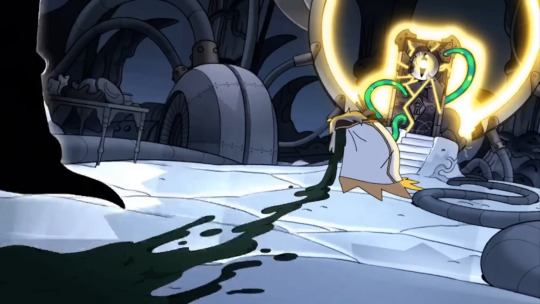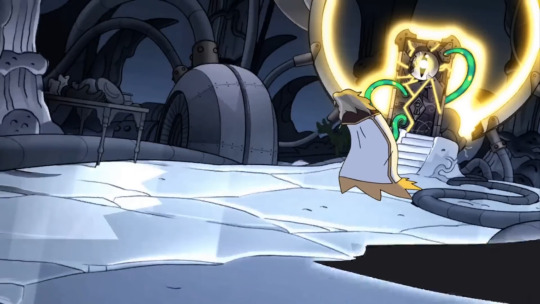#I think that Philips’ story and reactions to the narrative ghosts he created are interesting
Text


The Collector taunting Belos and Belos lashing out had me 👁👁
The Collector had some pretty specific taunts locked and loaded and Philip couldn’t help but lash out at them “what if it’s changed, what if you’ve changed, you can barely hold your human form anymore” those are presumably Philips’ biggest fears that the world he once knew all those hundreds of years ago has changed without him and that he’s changed too much to go back… that he isn’t as human as he used to be and he can’t face the reality that he looks just like the thing that he’s spent his whole life hating and hunting. The sunken cost fallacy is one hell of a drug.
#you can’t tell in the screenshot but his hand is trembling in the second one#look on the table and you’ll see a familiar circle 🌙#the owl house spoilers#toh spoilers#emperor Belos#Philip Wittebane#the Collector#the Collector toh#I think that Philips’ story and reactions to the narrative ghosts he created are interesting#1 ghost being his own brother and the 2nd being his own humanity
316 notes
·
View notes
Text
A Ballet ‘Jane Eyre’? Reader, She Dances With Him
“You feel trapped, like the walls are closing in,” said the ballet mistress, demonstrating a sequence of frantic, elbow-jutting arms. “Keep the legs low, it’s not about the height, it’s about wanting to get out of here.”
Devon Teuscher, Misty Copeland and Isabella Boylston, the American Ballet Theater principals who are all cast in the title role in Cathy Marston’s “Jane Eyre,” opening at the Metropolitan Opera House on Tuesday, listened intently as they copied the movements and tried to absorb the intentions behind them. It was February, and an early rehearsal for the full-length ballet, based on Charlotte Brontë’s 1847 novel.
With its first-person narrative and intense focus on an interior consciousness, Brontë’s novel isn’t an obvious candidate for a ballet. But Ms. Marston, 43, a British choreographer who has slowly forged a reputation for her ability to create narrative works, seems undaunted by the challenges of transmuting literary complexity into dance.
It was the strength and unpredictability of Jane’s character that attracted her, she said, adding that she was often drawn to strong women as protagonists, including Mrs. Alving in Ibsen’s “Ghosts,” Cathy in “Wuthering Heights” and Queen Victoria — all characters around whom she has created ballets.
Jane, she added, “is a kind of early feminist, fighting both the world and questioning her own emotions and reactions.”
“Jane Eyre,” to a score by Philip Feeney that incorporates music by Schubert, Felix Mendelssohn and Fanny Mendelssohn, was first created for Northern Ballet in England in 2016. It has proved a game changer for Ms. Martson.
British critics praised the clear storytelling in “Jane Eyre,” Ms. Marston’s craft and her innovative physicality. This Jane is “emancipated from the conventional tropes of the ballet heroine,” Judith Mackrell wrote in The Guardian.
After years of relative obscurity, Ms. Marston was suddenly on the radar. Helgi Tomasson, the director of the San Francisco Ballet, invited her to create a work (“Snowblind”) for the company’s “Unbound” festival last year; she also made a full-length ballet, “Victoria,” about the queen, for Northern Ballet. A new piece for the Royal Ballet is scheduled for February 2020.
“It’s funny how things slowly trickle through,” Ms. Marston said over coffee at the Royal Opera House in London recently. “Once you have a couple of big companies backing you, others follow suit.”
She acknowledged that the pressure on ballet directors to find and feature female choreographers, hasn’t hurt. “The woman thing is certainly part of it,” she said. “And I think that companies know that narrative ballets often end up being productive for all in the end, and I have a lot of experience with narrative ballets by now.”
Kevin McKenzie, the director of American Ballet Theater, said he first heard about Ms. Marston after “Snowblind” was commissioned. “Then her name kept coming up,” he said. “I liked that she was a storyteller at heart and the sound of her process.” Still, when he met her after her stint in San Francisco, “I had to be blatantly honest and say I had never seen anything she had done.”
After that meeting, Ms. Marston sent Mr. McKenzie videos of her work, including one of “Jane Eyre,” which he found “unusual and fascinating.” He asked her to create a new one-act ballet for Ballet Theater’s fall 2020 season. Then a crisis loomed. A full-evening program planned for this year’s Met season fell through. Mr. McKenzie thought of “Jane Eyre.” “I told Cathy that if she could figure out how to stage the ballet in a short time, let’s do it.”
Ms. Marston didn’t hesitate. “You have to grab the moment,” she said firmly.
Her interest in choreography began early. She took part in workshops and looked up to older students like Christopher Wheeldon and David Dawson, who were making choreographic inroads. There was certainly a glass ceiling, she said.
“I wasn’t the ballerina type, and I didn’t get offered a place in the company,” she said. “The fact that I was a choreographer, and had won the school’s choreographic prize, didn’t make a difference, whereas I think for a man it probably would have.”
Instead, she joined the Zurich Ballet in Switzerland, later moving to companies in Lucerne and Bern. She continued to make dances and in 2001 returned to Britain, determined to focus on choreography. There she created “Ghosts,” her first full-length work, in 2005.
“Ghosts” led to an offer to direct the Bern Ballet, where she worked from 2007 to 2013, choreographing more than a dozen works, but also commissioning pieces. It was, she said, “a huge wake-up call about what it means to be a director.” (And for the moment that’s off the table: “I have two children, and I want to be a mother and a choreographer and a cultural leader,” she said. “But I’ve realized I don’t have to do all of that fully at the same time.”)
Her exposure in Bern to German regietheater (or, director’s theater), in which the director plays freely with the playwright’s original directions or intentions, was important in helping her develop a method of storytelling, she said. “I began to question whether I really had to use period costume if I was telling a period tale, whether I needed props, how much could be symbolic,” she said. “Without a point of view, I realized all the work just looks the same.”
Her love for narrative ballets, she said, comes from her home life — her parents were both English literature teachers — and from training at the Royal Ballet School, where she absorbed the influences of Frederick Ashton and Kenneth MacMillan, “all those costume dramas and great stories.”
So far, Ms. Marston has intrepidly tackled “A Tale of Two Cities,” “Lady Chatterley’s Lover,” “Three Sisters” and “Dangerous Liaisons,” among other literary subjects. “I am drawn to relationships, the development of emotion, history, memory,” Ms. Marston said. “Of course there are things dance can’t say, and that’s a stickier corner to get around.”
But as Jenny Tattersall, the ballet mistress teaching the Ballet Theater dancers, indicated as she demonstrated the steps, Ms. Marston, unusually, gives every step a specific meaning or intention. “It’s very different from what we are used to, which is learning the steps and then figuring out how you want to interpret it,” said Ms. Teuscher, who is performing the role of Jane on the first night. “Here, it happens all together, and at first I found it difficult to process. But then once you have it, everything is very clear: This is the story, and this is how it’s told.”
Although Ms. Marston’s sources tend to be set in the past, her physical vocabulary can be contemporary and unconventional, with a considerable amount of floor work and off-balance partnering in which the women often bear their partners’s weight.
“There is a lot of counterbalancing in the partnering,” said James Whiteside, who performs the central male role of Rochester in “Jane Eyre.” “In conventional ballet, the man is often just holding the woman upright. Here we do a lot of dropping to the ground, and I make a lot of noise. I’m working on finessing that.”
Ms. Marston said she was very conscious of the way that classical ballet suggests gender roles. “A contemporary vocabulary allows us to show women differently,” she said. “You need the full range, so that women can partner and support men, in order to express what women actually feel and do. There is a long way to go there. It should give me a job for the next 20 years.”
Jane Eyre
Tuesday through Monday at the Metropolitan Opera House, Manhattan; abt.org.
Sahred From Source link Arts
from WordPress http://bit.ly/2MuwBzF
via IFTTT
0 notes